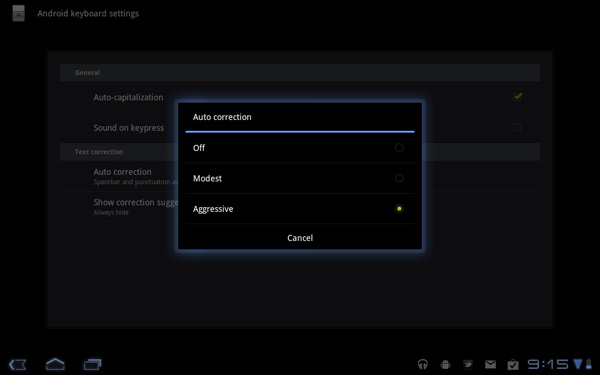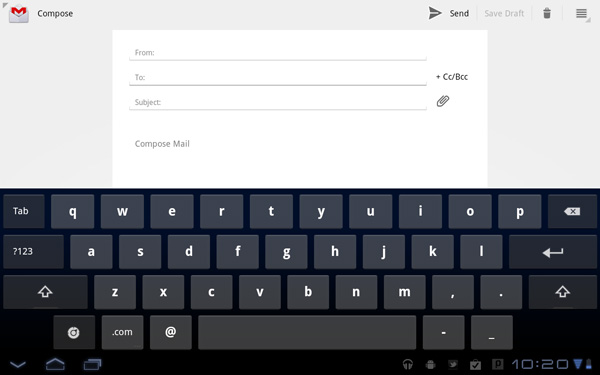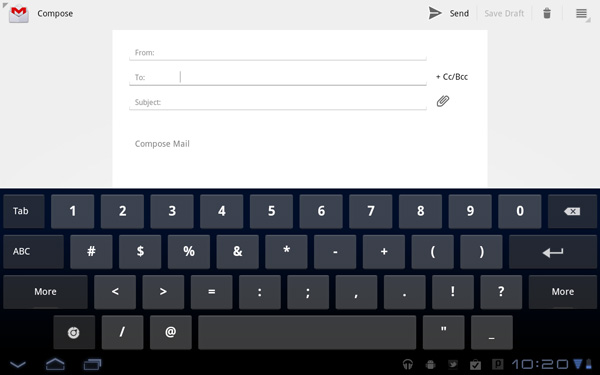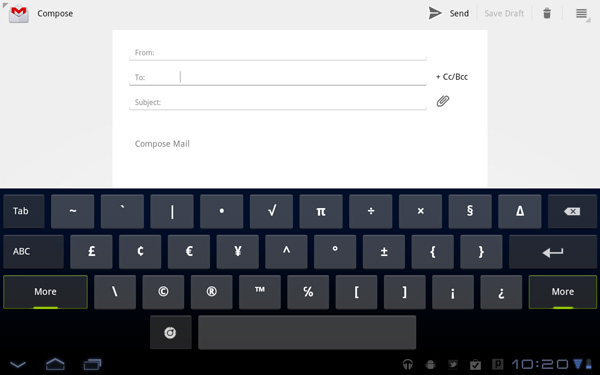Motorola Xoom Review: The First Honeycomb Tablet Arrives
by Anand Lal Shimpi on February 23, 2011 11:57 PM ESTThe Android Tablet Keyboard
In our iPad review I complained that Apple purposefully turned down the autocorrect aggressiveness, which resulted in a more frustrating typing experience than on the iPhone. Google clearly struggled with the same decision, but left the option up to the end user to configure. There’s a new option in the input device settings to set how aggressive you want the autocorrect to be:
The main difference between moderate and aggressive seems to boil down to spatial recognition for typing errors. On Android and iOS the keyboard looks at the length of the word you’re typing, letters involved as well as the location of the letters selected when comparing to the built in dictionary. In my experience, Android tends to look more at word length and letters involved than it does the physical location of the keys you’re pressing. I’m not actually sure how much Android does the latter, but iOS seems to rely on it pretty heavily. Setting Honeycomb’s autocorrect to aggressive makes the Android keyboard behave a lot more like the iOS keyboard in this regard.
The main issue with aggressive autocorrect is when you’re intentionally typing a word that’s not in the dictionary. Aggressive autocorrect will typically correct it while moderate autocorrect won’t. I’ll give you an ironic example: the name Xoom.
With autocorrect set to moderate, Honeycomb will let you type Xoom without complaining. Set to aggressive, Honeycomb will look at the location of the letter X on the keyboard, realize it is close to the letter Z and assume you meant to type Zoom.
At the same time, where aggressive autocorrect comes in handy is when you actually make a spelling mistake due to a misplaced tap. Take the word "pool". If you accidentally type "pook", moderate autocorrect won’t do anything to the word. It’ll realize it’s not in the dictionary but it is not a blatantly misspelled version of another word. Aggressive autocorrect will realize that the letter k is next to the letter l on the keyboard, assume you meant “pool” and make the substitution.
Google also lets you disable autocorrect entirely but I’m not personally a fan. I’m torn as to what method I prefer on a tablet. Both can be frustrating at times but for different reasons. I feel like aggressive autocorrect is the best option if you have a mature dictionary to check against. By mature I don’t mean that it contains words of mature content, but rather it knows all of the words that you type frequently.
By default, Honeycomb takes a simplistic approach to autocorrection: the suggested words bar is hidden. Unfortunately this means there’s no quick and easy way to manually add words to the dictionary. Thankfully Google lets you show the suggestion bar all the time if you’d like, or only when in portrait mode if that tickles your fancy. Based on what I’ve seen I’d recommend using aggressive auto correct once you’ve added a significant number of words to the dictionary.
The virtual keyboard itself is pretty nice. Key spacing is good both in portrait and landscape modes and the learning curve isn’t too steep. It’s still faster (and less painful) to type on a physical keyboard, but for banging out short messages, emails and URLs - the virtual keyboard works.
My only real complaint about the virtual keyboard is the location of punctuation keys. Google gives you access to commonly used punctuation (comma, question mark, exclamation point) without switching keyboard modes, but the position of the punctuation keys takes some getting used to - they don’t cleanly map to where you’d find them on a normal QWERTY keyboard. I feel like for first time users Apple got the layout a little better, but the point is moot - as long as you don’t go back and forth between an iPad and a Xoom you’ll get used to it.














112 Comments
View All Comments
GotThumbs - Friday, March 18, 2011 - link
Hold out a little longer...599 WIFI only coming March 27th. Hope you didn't buy the Archos yet. Early adopters always pay more $$$. If you just wait a little while...the prices always adjust after buying slows down at higher price. Thats just the economics of it. Apple is able to sell at higher prices, so why would they lower them.GotThumbs - Friday, March 18, 2011 - link
Coming out Mrch 27th. Hold on a little longer for a better tablet. My boss offered to buy me the new IPAD2 the other day. I told him 'no thanks, its either an ADAM or a Xoom or nothing" The ADAM is still developing their production and having growing pains.....the product is excellent and will be a great addition to the tablet market when it arrives in stores...for now...its Xoom. Now with the WIFI version coming out...it will boost sales for those consumers who did not want the 3g option and high cost.Android_Blogger - Monday, March 21, 2011 - link
Apparantly, the 3G version costs 600 GBP in the UK at least. Source: <a href="http://www.motorola-xoom.co.uk/">UK Xoom Tablet blog</a>Android_Blogger - Monday, March 21, 2011 - link
Source:www.motorola-xoom.co.ukspambonk - Sunday, April 10, 2011 - link
What I don't get are the specs on Amazon which says this device also has a 2.1 GHz Intel Core 2 Duo Mobile inside??? What, it has both a tegra and a intel core 2??? What is this madness.fentleson - Friday, April 15, 2011 - link
Better screens. Resolution isnt as important as screen quality.vtx1300 - Friday, April 15, 2011 - link
HD front and rear cameras - USB2/3, GigE and E-SATA connections and a Free (commercial sponsored?) Data PlanDixon Butz - Sunday, April 17, 2011 - link
I want to see a slide out keyboard. Or a mini removable keyboard.911dude - Wednesday, April 20, 2011 - link
I'm wondering about the effect that the pending ATT buyout of T-Mobile will have on the future of Xoom.ANDROCELES - Friday, April 22, 2011 - link
I HOPE 2 TRY ONE